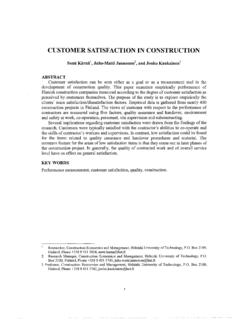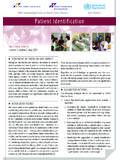Transcription of What are the big issues in cost management?
1 1 What are the big issues in cost management ? Mahanim Hanid1, Mohan Siriwardena2, Lauri Koskela3 ABSTRACT This paper presents the current big issues in cost management . It covers the theoretical aspects, the causes and effects, and possible countermeasures. This paper is a result of a literature review conducted during the initial stages of a doctoral research. In doing so, principles of lean production are considered as a basis for critical evaluation. Seven big issues have been identified as shortcomings in the current construction cost management approaches.
2 Some of such issues identified are failure to forecast, failure to pinpoint improvement opportunities and poor support to inter-organizational cost management . Possible countermeasures are suggested to address the identified issues . This research is expected to contribute towards developing conceptual solutions for improving the cost management approaches. KEYWORDS: Cost management , lean, value, waste. INTRODUCTION Cost management can be generally considered as a set of techniques and methods for controlling and improving a company s activities and processes, its products and services, to achieve cost effectiveness (cost reduction, value improvement and substitution) by collecting, analyzing, evaluating and reporting cost information for budgeting, estimating, forecasting and monitoring costs, in order to assist decision making.
3 Since the seminal contribution by Kaplan and Johnson (1987), literature indicates extensive discussions highlighting the need for improvements in cost management . Through a review of such literature, this paper aims to establish and consolidate the big issues in construction cost management , especially when analyzed from lean production perspectives. Following this introduction, each big issue is discussed in terms of introducing the issue , the causes, an explanation, and possible countermeasures.
4 A discussion identifying areas of commonality, consequences of the weaknesses, and areas for improvement are identified. Finally, conclusions and further research directions are indicated. 1 Phd Candidate, School of the Built Environment, University of Salford; UK. Phone +44 161 2953458; 2 Lecturer, School of the Built Environment, University of Salford; UK. Phone +44 161 2957052; 3 Professor, School of the Built Environment, University of Salford; UK.
5 Phone +44 161 2956378; 2 BIG issues IN TRADITIONAL COST management FAILURE TO FORECAST Forecasting is one of the key functions of cost estimation in construction projects. Zwikael and Smyrk (2009) have defined project as a form of investment in which outlays (approved by funder ) are made today with the intention of realising a flow of benefits over some future timeframe. Cost estimation is used to establish the probable cost of a future project or product, before designed in detail and contract particulars being prepared.
6 In this way, the client is made aware of the likely financial commitments before extensive design work is undertaken (Seeley, 1983) and it can help in providing correct input to him for making the correct decisions on future investments. Forecasting has been discussed as part of attempts to improve accuracy in estimating (Jaya et al., 2010, Rosenfeld, 2009, Beeston, 1986, Ballard, 2008, Kenley and Wilson, 1986). However, Flyvbjerg (2008) and Elfving et al. (2005) believe that these endeavours have not been fruitful.
7 Many causes of inaccuracy have been pinpointed in previous research. Traditionally, it is common for building owners to decide on relatively detailed issues at the beginning of the project delivery process for the preparation of tender documents. There is a high possibility that the detail issues in the design at this early stage will change along the project delivery process, hence causing a considerable amount of waste in terms of time, information provided, and waste created during construction due to design faults (Elfving et al.)
8 , 2005). In addition, cost is just understood to be there and the focus is on targeting for the expected cost and not for targeted cost . Flyvbjerg (2008), introducing the term dark side of forecasting , points out unethical practices such as project champions / person in-charge (planner & the politicians) proceeding with projects even when inaccuracy in estimating is detected at the outset. Currently, most of the cost data are taken from previous projects, which inherit waste. Such waste can be in varying amounts due to the emerging nature of waste.
9 This fact is not acknowledged when compiling and using cost data, thereby resulting in inaccuracies in cost estimates. Therefore, a possible countermeasure is to develop cost management approaches which account for the emergent nature of waste in the total construction process. FAILURE TO PINPOINT IMPROVEMENT OPPORTUNITIES Current practices have witnessed many estimators being more keen on getting projects to be funded and built (Flyvbjerg, 2008) rather than getting the forecast right.
10 In addition, early commitments to design solutions have established cost at the initial stage. Locking the cost and the design, reduces the opportunity to decrease the cost during construction, even though many authors have agreed that 70%-80% of product costs are committed during the concept phase (Rush and Roy, 2000). It is also highlighted that making a wrong decision at this stage is extremely costly further down the development process where product modifications and process alterations are more expensive.





